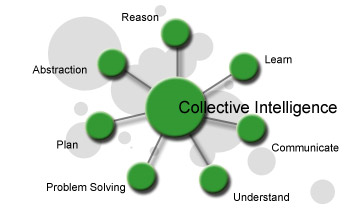 Solving issues, challenges, concerns, and simple brainstorming by calling on the Collective Intelligence within the knowledge and experience of your team of co-workers is an infrequent manifestation in most businesses. Think about all that brainpower and the capacity it has to hurdle any obstacle, and you realize what an untapped resource you are probably underutilizing. One of the magic’s of the weekly meeting is a dedicated time frame called Collective Intelligence where your team provides obstacles or ideas to discuss. It applies the intellect of your team to solve challenges which would otherwise remain frustrations obstructing progress in your business. The 15-45 minutes (depending on your weekly meeting designated length) will be the most productive time you receive from your business. Here some stories from clients on why:
Solving issues, challenges, concerns, and simple brainstorming by calling on the Collective Intelligence within the knowledge and experience of your team of co-workers is an infrequent manifestation in most businesses. Think about all that brainpower and the capacity it has to hurdle any obstacle, and you realize what an untapped resource you are probably underutilizing. One of the magic’s of the weekly meeting is a dedicated time frame called Collective Intelligence where your team provides obstacles or ideas to discuss. It applies the intellect of your team to solve challenges which would otherwise remain frustrations obstructing progress in your business. The 15-45 minutes (depending on your weekly meeting designated length) will be the most productive time you receive from your business. Here some stories from clients on why:
In the past several weeks the following were topics discussed at the weekly meetings in collective intelligence from two of my clients: Sales Force Realignment, Industry Trends, Full-Time HR Position, The Great Game of Business (Book & Application to their business), vacation and holiday compensation, outside source for generation leads, organic growth of sales position, strategies to grow sales pipeline, salesperson hiring process, display art for trade show booth, company work process flow chart (7-9 essential systems), testimonials, pricing model and much more.
Several of these topics resulted in impactful changes for my customers. One determined that their approach to hiring sales people should be changed. They decided to outsource lead generation and develop their next sales person by first assimilating them through the company to learn the value it offers prospects and customers before placing them in the role of converting leads/prospects. It’s been a challenging process to find sales people for this business based on the nature of their service. After several recent hires didn’t work out they decided to look hard at their process and determine if it was poor hiring decisions, or not having defined the position and process. Ultimately they determined they had several people internally functioning well in the role of sales conversion. They desperately need to drive more leads. For the time being they determined an outside resource can do that part of the lead generation process better than they could, and for a lower investment then hiring a salesperson to focus on this.
Another customer is debating the configuration of their sales force. They presently have account managers, merchandisers and sales reps. What’s the proper number to have in each category? Is having one person do two or all three roles better or worse use of efficiency?
We discussed the Great Game of Business and the value of transparency of financial information and the incentive this would provide. The company determined that they were on this path already, sharing financial data with departments and developing incentives to reward contribution to the bottom line on a trimester and annual basis. Long term the Great Game may deserve another look in the future.
There was a discussion on the fairness of their present holiday and vacation compensation, since some employees don’t take their share of vacation each year, and then get paid for the weeks they don’t use. How is compensation paid for commission versus salary and union workers, and what’s fair? Another discussion surrounded whether at their present level of employees (over 100) it merited changing their Human Resources position to a dedicated full time position with HR training and education.
In the past we reviewed sales presentations to get everyone’s input, discussed theme and incentive programs, one of which resulted in an annual theme that decreased returns for a beverage company by over $600,000.
Discover the power of your leadership team’s Collective Intelligence. Gather the issues, concerns and discussion points at each weekly meeting that impact your business. Once collected, decide which ones are priorities and then have someone lead the discussion searching for the best solution. McKinsey in their excellent 2007 survey on Internet Technology, “Collective Intelligence refers to any system that attempts to tap the expertise of a group rather than an individual to make decisions.”
You’ll quickly enjoy the impact that comes from your team’s observations, contributions, and discovery. Solve your most pressing issues and discover the impact of Collective Intelligence in just 15-45 minutes of each week! One of my clients requires I make sure we move through the Good News, Numbers and Customer and Employee Feedbac, Accountability pieces of the weekly meeting so we always have 45 minutes for Collective Intelligence. He finds it that constructive!
If your meetings are not aligned you’re not receiving the full benefit of Strategic Disciplines execution and strategic value in your business.
For an opportunity to learn more about Strategic Discipline and the power of the Rockefeller Habits register now for the Mastering the Rockefeller Habits Four Decision Workshop coming to Cedar Rapids, Iowa April 29th. Bring your leadership group to really stimulate the value of collective intelligence and learn first-hand how to implement the critical pieces that can make your business soar!

 Making good decisions in these challenging times requires leadership that listens to their employees and customers for feedback and then has the courage to change. The following is an example of one of my clients who has consistently beaten challenges and recently made a remarkable innovation that required considerable risk. First a little background on All County Music and Fred Schiff’s leadership capabilities.
Making good decisions in these challenging times requires leadership that listens to their employees and customers for feedback and then has the courage to change. The following is an example of one of my clients who has consistently beaten challenges and recently made a remarkable innovation that required considerable risk. First a little background on All County Music and Fred Schiff’s leadership capabilities. Fred intuitively understood (quoted in an article from Music Inc), “There are certain parts of the market that want to be niche, where [customers] want to experience something they can’t get somewhere else.” Investment in this innovation was $10,000 not including his stock.
Fred intuitively understood (quoted in an article from Music Inc), “There are certain parts of the market that want to be niche, where [customers] want to experience something they can’t get somewhere else.” Investment in this innovation was $10,000 not including his stock. Accessory and flute service repairs have far exceeded is projections. The initial investment has been earned back.
Accessory and flute service repairs have far exceeded is projections. The initial investment has been earned back. It’s packed full of stories and examples of companies who have made dramatic leaps forward in growth and profitability by focusing on customer satisfaction. Reichheld’s evidence shows that companies providing superior customer satisfaction grow at 2.6 times their competition.
It’s packed full of stories and examples of companies who have made dramatic leaps forward in growth and profitability by focusing on customer satisfaction. Reichheld’s evidence shows that companies providing superior customer satisfaction grow at 2.6 times their competition.